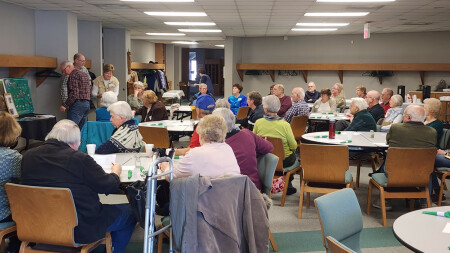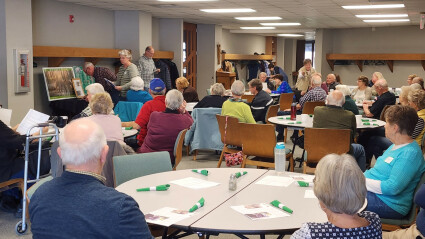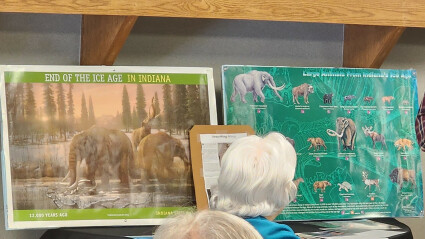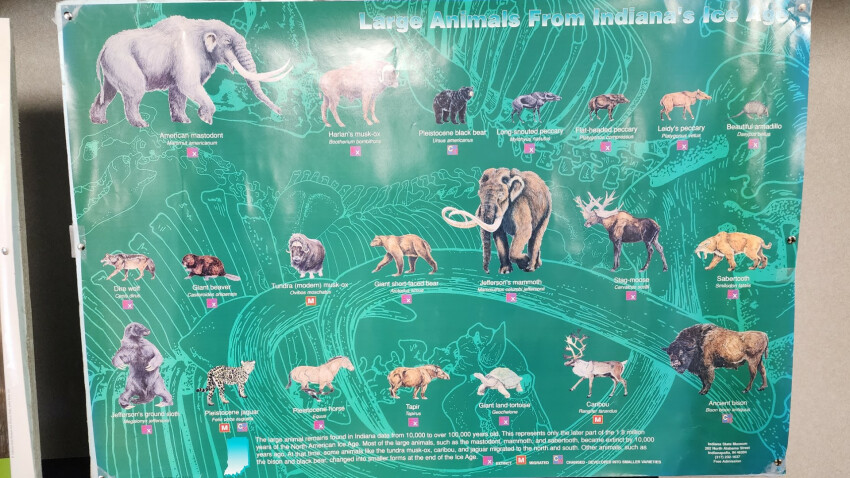 The March Lunch and Learn was a gathering of mastodonophiles to hear Joe and Rita Schepman and Tony and Sue (Joe’s sister) Nehrt explain what to do if you find mastodon bones in your backyard.
The March Lunch and Learn was a gathering of mastodonophiles to hear Joe and Rita Schepman and Tony and Sue (Joe’s sister) Nehrt explain what to do if you find mastodon bones in your backyard.
Joe related he currently farms land in the Seymour, Indiana area. This land was farmed by his grandfather, Alfred, over 100 years ago. In 2019 the city embarked on a project to extend the sewer line which ultimately crossed their farmland. During the excavation, the contractor unearthed some large bones, which were placed in the bed of a truck, and called a conservation officer for identification. The officer called Joe’s brother-in-law, Tony Nehrt, to meet at the digging site. A family member had a previous experience with bones being unearthed but those turned out to be chicken bones. Arriving at the dig site, Tony could see these were not chicken bones!
On April 13, 2019, two representatives from the Indiana State Museum looked at the bones in the truck and readily identified them as mastodon bones. The museum already had a full-size mastodon skeleton on display and wasn’t sure they wanted these bones.
 However, seeing the bones change color as they rapidly dried, and needing to preserve them, the museum instructed the Schepmans to wrap the bones and keep them moist and the museum would accept to keep them. Springtime on the farm meant work preparing for the planting season, so the task of preserving the bones by keeping them moist fell on Rita. Within two weeks, the bones had been transferred to the museum.
However, seeing the bones change color as they rapidly dried, and needing to preserve them, the museum instructed the Schepmans to wrap the bones and keep them moist and the museum would accept to keep them. Springtime on the farm meant work preparing for the planting season, so the task of preserving the bones by keeping them moist fell on Rita. Within two weeks, the bones had been transferred to the museum.
It wasn’t long before Joe got a call from the local newspaper to do a story on tis find. That led to a connection to a national story and television news.
A Ball State University representative said they could bring equipment to survey for more bones, but it would be expensive. If more were in the area, it would tear up more farmland than the trench dug for the sewer line. The representative came to see the area on a rainy day. Joe said the area has always been swampy and the Ball State man quickly sank into the muck which sucked off both his shoes. (He did retrieve one.) He said he always carries spare shoes and socks with him for just this reason.
The collection of bones, now named “Alfred” after Joe’s grandfather, were radiocarbon dated to be 13,000 years old. The mastodon was described as a 42-year-old male standing 9 or 10 feet tall at the shoulder. A tusk that was discovered was 4 feet long. Likely the mastodon died in this swampy area and over time sank into the muck.
In February 2020, Joe said the family went to the museum to see “Alfred” and were impressed at the museum display. He recommended the trip to everyone. Mastodon bones have been found in all 92 counties in Indiana.
Click here to see an article from Beck's CropTalk Newsletter.
Click here to see an article from the Seymour Tribune.
Q&A session —
- How to preserve bones — soak in Elmer’s glue – the glue goes into bone cavities to eliminate oxygen
- Cost of radiocarbon test ¬— about $800
- Is sewer project done — Yes, this trench was about 6 feet deep, but since this is a gravity flow system, the trench farther down the line could be 15-20 feet deep. The project took a year on their land, but they can now begin to farm it again.
- Did the family keep any bones — Tony kept part of a tusk, preserved it and will have a mastodon figure engraved on it for grandchildren. They also have many arrowheads they have found over the years.
- Has anyone asked to come and dig — No, thankfully, but the museum says it is likely the rest of the skeleton is still buried.
Submitted by Billy Batson (aka ???)







